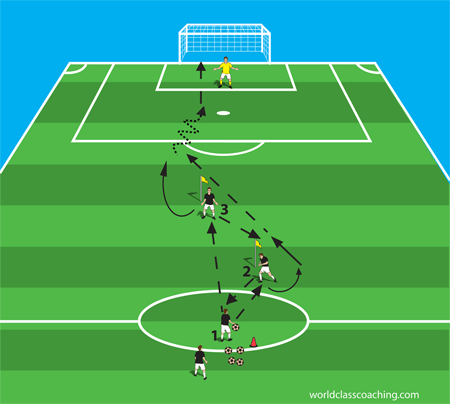I've written about my teams transition to playing a 4-3-3 in previous posts. The process has been going really well. I've been very pleased with how we are defending with the system. This was a concern for me because I could see how we were going to be able to deal with the other team's wide players. The girls have done well sharing this responsibility between the winger, attacking midfielders and wing backs.
We've been able to create a lot of offense using the wingers and wing backs getting forward. The player we haven't used much is our center forward. The spaces in the middle have been so congested that it's been easier to get the ball wide and attack from there.
This week I want to work on attacking combinations in the middle of the field. We have a number of good resources for this type of session. An article in the September Magazine Update to our Member Drills Database includes a great session from Jan Pruijn of Ajax International. The session was originally presented at the Nebraska WORLD CLASS COACHING International Coaching Seminar held last February in Lincoln, NE.
Another great resource is Player's Roles in the 4-3-3. One of the two books focuses on the attacking aspects of the formation. This book has a number of good exercises that will give your players attacking ideas from central areas. The activity below is one of them.
Attacking Training Session#13– Central attack choreography: center forward penetration.
Introduction: The center forward in the 1-4-3-3 must be a potent combination of technically-sharp, quick, strong, aggressive in the air and decisive in her play. Schemes to get her in behind the defense often begin with a ball played into her feet, designed to pull apart and freeze the opposing center backs, followed by a lay off pass and a looping run off of the ball into a seam in the defense. This session presents an example of this type of combination taken from West Ham staff coach Tony Carr, followed by a pair of functional schemes for getting the center forward in behind the defense.
West Ham Combination Play 15x25 yard areas
Players are organized into groups of 4-6 players as shown, with one player at each of the coaching sticks (defenders) and the balance on the near end, where there is also a ball supply. Player 2 checks away from the ball at an angle and then back to player 1, who plays into her feet. The ball is returned first time and then player two spins off away from the ball. Player 1 then plays in to the feet of player 3, who has checked away and then posted up on her defender. Player 2’s run takes her into a supporting position behind and at an angle to player 3, who lays the ball off to player 2 and then spins off away from the ball and looks over her inside shoulder, penetrating behind the defender after the ball is played through. Player 3 attacks the goal. Player 1 takes player 2’s position and player 2 takes player 3’s position.
Progression:
- Replace the coaching sticks with defenders, who provide pressure, but do not disrupt the movements.
Coach:
- Precision runs. Making well-timed, predictable (for one’s teammates) and full-effort runs is critical to the success of these movements under pressure.
- Timing. The final run must be made in such a way that the runner will be on-side. The attacker must coordinate with the player playing the penetrating ball by quickly getting away from the defender, looking over her inside shoulder and making a sharp, looping run that builds in time for the passer to set the timing of the pass and also allows the runner to build up speed to run onto the ball at a sprint. The angle is also critical, as the runner’s angle cannot make the passing angle easy for the defender to cut out.
Technical detail. The pace and placement of the passes must work in rhythm with the running off of the ball.
There are a wide variety of progressions that you can use off of this set-up. The author, Tony Englund, also progresses this session to include defenders and eventually transforms it into a small-sided game.
Have a Great Day!
Tom Mura



